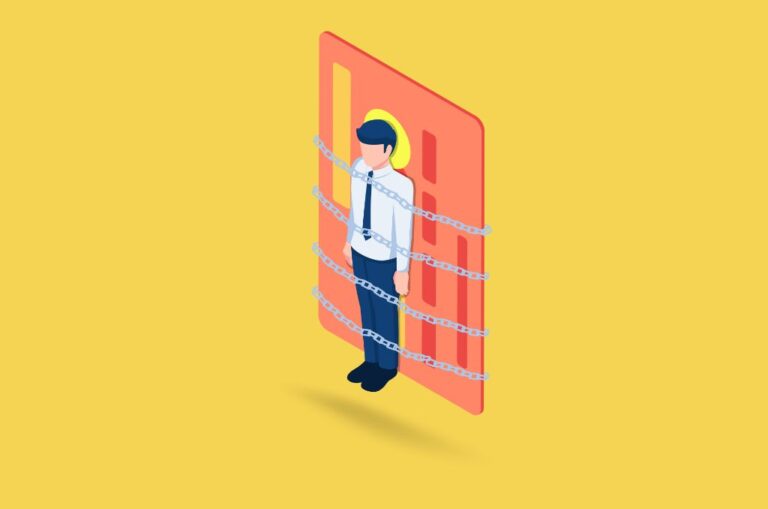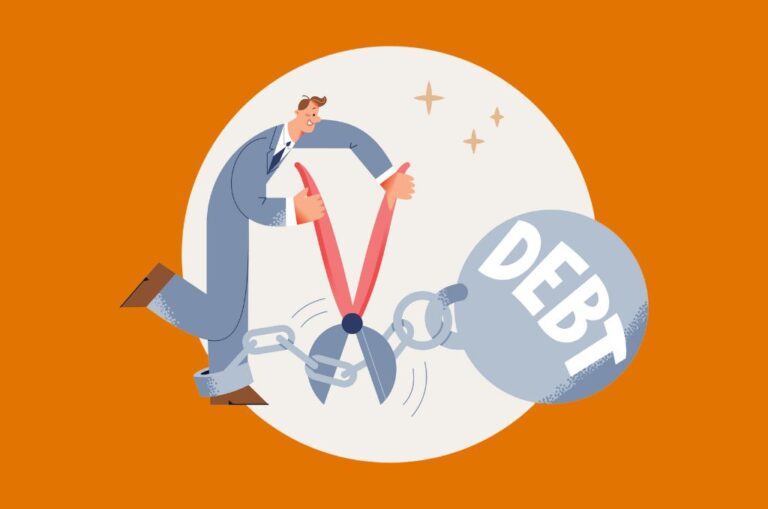Let’s be honest, credit cards can be confusing. They can feel like awesome tools that let you buy things you want now, but then BAM! They turn into scary monsters that charge you extra fees if you don’t pay them back fast.
We’ve all been there, swiping the card without thinking, only to get a bill at the end of the month that makes us want to hide under the bed.
Studies by Experian show that the average U.S. consumer carries around 3.9 active credit cards in their wallet. This means the typical person juggles a handful of cards, but older consumers and those with higher credit scores might have more.
But worry not, my friend! This guide is here to help you understand credit cards and how to avoid getting stuck with a ton of debt.
Credit Cards are Like Borrowing Money from a Friend (with a Catch!)
Imagine your credit card is like borrowing money from a friend. They let you borrow some cash to buy something cool, but they expect you to pay them back – with a little extra on top!
That extra bit is called interest, and it’s like a fee for borrowing the money. The longer you take to pay your friend back, the more interest you owe them.
The same goes for credit cards – the longer you take to pay off your balance, the more interest you rack up, making the debt monster bigger and scarier.
According to a Forbes Advisor study, a staggering 82% of adults in the US hold credit cards, and the average credit card debt per borrower reached a record high of $6,360 at the end of 2023. These numbers paint a clear picture: credit cards are widely used, but they can also lead to a significant debt burden if not managed responsibly.
Credit Card Trouble? Fix It Now!
You might feel alone in this struggle, but trust us, you’re not! Credit Card Debt is Super Common (Seriously!)
Those monthly payments can gobble up all your extra cash, making it hard to save for things you really want, like a vacation or your own place. Even worse, if you don’t pay your bills on time or owe too much money, your credit score can take a hit. This score is like a report card for your finances, and a bad one can make it difficult to get loans, rent an apartment, or even land a job. Yikes!
But the good news is, with some smart strategies, you can manage debt and build a strong financial future. Let’s begin!


How To Choose The Right Credit Card?
We’ve talked about credit cards and how they work. Now it’s time to pick your own! Just like clothes, there’s no one-size-fits-all credit card.
So, let’s explore the different types and find the one that best suits your spending habits, like a financial superhero cape!
Credit Card Types: Not All Heroes Wear Capes (or Have High Interest Rates)
There are several credit card types, each with its own strengths and weaknesses. Here’s a quick rundown:-
1. Rewards Cards: These cards shower you with points, miles, or cash back for your spending. Think of them as giving you a little something extra every time you slay a purchase with your plastic sword (card). But be warned, some rewards cards have high interest rates, so make sure you pay your balance in full each month to avoid the debt monster’s wrath.
Check out the best Rewards Credit Cards
Advertiser Disclosure: Penny Calling Penny has partnered with CardRatings for our coverage of credit card products. Penny Calling Penny and CardRatings may receive a commission from card issuers.
2. Low-Interest Cards: These cards prioritize low interest rates, making them ideal if you need to carry a balance occasionally. However, they typically don’t offer many rewards.
3. Secured Cards: These cards are a great option for building credit history or if you have limited credit history. You put down a deposit (like a security blanket for your borrowing!) that becomes your credit limit. Once you use the card responsibly and build your credit score, you might be upgraded to an unsecured card with more benefits.
4. Student Cards: These cards are designed for students with limited credit history. They often have lower credit limits and may offer student-specific perks.
Interest Rates and Fees
Interest rates are like the toll fees on the credit card highway. The higher the rate, the more you pay for borrowing money.
So, when choosing a card, compare interest rates and aim for the lowest one you can qualify for. Also, keep an eye out for fees like annual fees, balance transfer fees, and late payment fees. These can add up quickly, so avoid cards with excessive fees.
Rewards Programs: Shiny Baubles or Helpful Companions?
Rewards programs can be tempting, offering cash back, travel points, or other perks. But remember, rewards shouldn’t be the only factor when choosing a card.
If you can’t pay your balance in full each month, the interest charges will likely outweigh any rewards you earn. So, choose a card with rewards that align with your spending habits and only if you can maintain responsible credit card use.
By considering these factors, you can choose a credit card that empowers you on your financial journey, not one that weighs you down with debt.
In the next section, we’ll explore strategies to use your credit card wisely and build a strong financial future!
Smart Spending Habits For A Debt-Free Future
Now that you’ve chosen your trusty credit card weapon, it’s time to hone your financial skills and become a master of your spending habits.
Remember, a credit card can be a powerful tool, but like any powerful tool, it needs to be wielded wisely. Buckle up, because we’re about to build a budget that will keep you in control and the debt monster at bay!
Budgeting, #1 Way To Tame The Debt Beast
Creating a budget might sound intimidating, but it’s actually quite simple. Here’s how to get started:
- Gather Your Intel: Collect your bank statements and pay stubs to get a clear picture of your income and expenses.
- Know Your Income: List all your income sources – salary, side hustles, etc. Be honest!
- List Your Expenses: Categorize your expenses into essentials (rent, groceries, utilities) and non-essentials (entertainment, dining out).
- Track Your Spending: Use a budgeting app, spreadsheet, or even a simple notebook to record your daily expenses. Be meticulous!
- Compare and Conquer: Compare your income to your expenses. Are you spending more than you earn? Identify areas where you can cut back.
Living Within Your Means
Understand the difference between Needs vs. Wants
Now that you have a budget, let’s talk about spending wisely. The key is to differentiate between needs and wants:
- Needs: These are essential for survival and well-being – rent, food, transportation. These take priority in your budget.
- Wants: These are things you desire but don’t necessarily need – that fancy new gadget, the latest fashion trends. These should fit within your budget after your needs are covered.
Tips For A Leaner Budget
Here are few ways to help you reduce unnecessary spending:-
- Cook More at Home: Eating out can drain your budget quickly. Explore the wonderful world of home cooking!
- Embrace Free Entertainment: Free concerts, museums on discount days, and picnics in the park – there are tons of fun ways to save money on leisure.
- Beware Of Impulse Purchases: The “buy now, think later” mentality is the debt monster’s best friend. Sleep on it before making a big purchase.
- Utilize Free Streaming Services: Ditch cable and explore the vast library of free movies and shows available online.
- Embrace Frugal Fun: Board game nights with friends, exploring local parks, or volunteering are all fun and budget-friendly activities.
By following these tips and building a solid budget, you’ll be well on your way to becoming a master of your finances and leaving the debt monster far behind.
In the next section, we’ll explore how to use your credit card responsibly and build a strong credit score!
Strategies For Responsible Use
Credit cards can be powerful tools, offering convenience and the potential to build credit. However, if not used responsibly, they can lead to a cycle of debt.
This section will equip you with the knowledge and strategies to navigate the world of credit cards with confidence.
The Benefits Of Full Payment
Making a full payment on your credit card balance each month is the most effective way to avoid debt. Here’s why:
- Reduced Interest Charges: Credit cards accrue interest on unpaid balances. By paying your balance in full each month, you eliminate these charges, saving you money in the long run.
- Improved Credit Score: On-time payments and a low credit utilization ratio (the percentage of your credit limit you’re using) are key factors in a healthy credit score. Paying your balance in full keeps both of these factors positive.
- Financial Security: Knowing you’re not accumulating debt fosters a sense of financial security and peace of mind.
Strategies For Consistent Full Payments
Here are some strategies to ensure you can consistently make full payments on your credit card:
- Budgeting and Tracking: Creating a budget that incorporates your credit card spending is crucial. Track your expenses diligently to monitor card usage and ensure you have sufficient funds for full payments each month.
- Round-Up Savings: Consider rounding up your purchases to the nearest ten dollars and allocating the difference towards your credit card payment. This small, consistent effort can significantly contribute to your full payment goals.
- Reviewing Spending Habits: Regularly analyze your credit card statements to identify areas where you can potentially cut back on spending, freeing up additional funds for full payments.
Understanding Minimum Payments and Their Drawbacks
Credit card companies often present minimum payments as a viable option. However, this approach can have significant drawbacks:
- Limited Impact On Balance: Minimum payments only cover a small portion of the overall balance. The remaining debt continues to accrue interest, causing the debt to grow over time.
- The Long-Term Cost Of Minimum Payments: Making only minimum payments can trap you in debt for years. You’ll end up paying substantially more in interest than the original purchase price.
Breaking Free From Minimum Payments
Here are some strategies to break free from the minimum payment trap:
- Increase Gradually: If paying your balance in full is initially challenging, consider gradually increasing your minimum payment by a small amount each month. This allows you to progressively chip away at the debt.
- Explore Balance Transfer Cards (Use with Caution): These cards offer a lower interest rate for a limited period. This strategy allows you to focus on paying down the principal without incurring additional interest charges. However, exercise caution and aim to pay off the transferred balance before the lower interest rate expires.
Setting Up Automatic Payments For Convenience
Automatic payments can simplify your credit card management and ensure on-time payments. Here’s how they work:
- Schedule and Automate: Choose a convenient date and set up automatic payments to cover your full balance each month. This eliminates the risk of missed payments and late fees.
- Reduced Stress: Automatic payments free you from the mental burden of remembering due dates, allowing you to focus on other financial priorities.
- Improved Credit Score: Consistent on-time payments facilitated by automatic payments contribute positively to your credit score.
Monitoring and Managing Credit Card Use
Credit cards offer convenience and the ability to build credit, but with great power comes great responsibility (or at least, some vigilance!). This section equips you with the tools to monitor your credit card usage and keep your finances in check.
Your Monthly Financial Report
Your credit card statement is like a monthly financial report card. Reviewing it regularly is crucial for maintaining control over your spending. Here’s why:
- Catching Errors: Statements can sometimes contain errors, like duplicate charges or miscalculations. Reviewing them helps identify and rectify these mistakes promptly.
- Fraudulent Activity Detection: Unfortunately, credit card fraud is a reality. Regularly reviewing your statement allows you to spot suspicious activity, such as unauthorized charges made in unfamiliar locations. Early detection helps minimize potential damage.
- Staying On Budget: Statements provide a clear picture of your spending habits. By reviewing them, you can assess if you’re staying within your budget and identify areas for potential adjustments.
Understanding The Credit Score
Your credit score is like a report card for your borrowing habits. Lenders use it to assess your creditworthiness, which can influence decisions like loan approvals and interest rates. Here’s what makes up your credit score:
- Payment History: This is the most crucial factor, accounting for roughly 35% of your score. On-time credit card payments are essential for building a good credit history.
- Credit Utilization Ratio: This reflects the percentage of your credit limit you’re using. Keeping this ratio low (ideally below 30%) demonstrates responsible credit card management.
- Credit Mix: Having a healthy mix of credit accounts, such as credit cards and installment loans (e.g., car loans), can positively impact your score. However, it’s important to manage them responsibly.
- Length Of Credit History: The longer your credit history, the better. This demonstrates your experience in managing credit responsibly over time.
- New Credit Inquiries: Frequent applications for new credit cards or loans can slightly lower your score in the short term. However, responsible credit card use can outweigh this negative impact.
Credit Card Usage
How you use your credit cards directly affects your credit score. Here’s how:
- On-Time Payments: Making consistent on-time payments is the cornerstone of a good credit score. Late payments can significantly damage your score and take time to recover from.
- Credit Utilization: Keeping your credit card balances low relative to your credit limits demonstrates responsible credit usage and positively impacts your score. Maxing out your credit cards will have the opposite effect.
- Overall Credit Management: Responsible credit card use, encompassing timely payments and maintaining low balances, builds a positive credit history and strengthens your score.
Strategies To Building A Stellar Credit Score
Here are some key strategies to elevate your credit score:
- Make Payments On Time, Every Time: Set up automatic payments or calendar reminders to ensure you never miss a credit card payment. Consistency is key!
- Maintain Low Credit Utilization: Don’t max out your credit cards. Aim to keep your balances below 30% of your credit limit. Consider requesting a credit limit increase if needed, but remember, it’s about responsible usage, not maxing out the new limit.
- Consider A Secured Credit Card (if needed): Secured cards require a security deposit but can be a good option for building credit if you have a limited credit history.
- Monitor Your Credit Report Regularly: Review your credit report frequently to identify and address any errors that might be negatively impacting your score. You can access free credit reports from each of the three major credit bureaus annually.
While the tips above are fundamental, there are tools available to help you build or rebuild credit. Consider exploring Credit Builder Loans offered by companies like Self. It can help you:-
- Build Positive Payment History: Self reports your on-time monthly payments to all three major credit bureaus. This consistent, positive track record is a key factor influencing your credit score (contributing 35%).
- Save While You Build: Unlike traditional loans, Self doesn’t give you cash upfront. Instead, you contribute towards a chosen savings goal with monthly payments over 24 months. The money is securely held in an FDIC-insured Certificate of Deposit (CD) at a partner bank. So, you’re building credit while saving for a future goal!
For example: Let’s say you contribute $25 every month for 2 years (24 months). At the end of that period, you’ll receive $511. This accomplishes two things: you build your credit score and save money. Essentially, Self Lending only charges you $89 for using their service for two years, as they return the majority of your contributions.

- Accessible Credit Building: Self’s Credit Builder requires no hard credit check to open an account. This is especially valuable if you’re looking to rebuild after credit challenges.
We Recommend You Explore Self Because:
- It offers a straightforward and secure way to build credit history.
- It combines credit building with a savings component, encouraging financial responsibility.
- It provides an opportunity to improve your credit score without a hard credit inquiry.
Ready To Take The First Step?
Head over to Self’s website to learn more about their Credit Builder plans and explore which option might be the best fit for your goals. With Self, you can take charge of your credit journey and unlock a world of financial possibilities.
Remember: Building a good credit score is a marathon, not a sprint. While Self’s Credit Builder can be a valuable tool, it’s crucial to maintain responsible credit management practices like making all future payments on time, across all your debts.
Avoiding Actions That Can Harm Your Score
Here are some actions to avoid that can negatively impact your credit score:
- Missing Credit Card Payments: Late payments are detrimental to your score. Prioritize on-time payments as a core financial responsibility.
- Maxing Out Credit Cards: Keeping your credit card balances high relative to your limit signals risky borrowing behavior and lowers your score.
- Frequent Applications For New Credit: While having a mix of credit accounts is beneficial, applying for too many new cards in a short period can negatively impact your score.
Setting Safe Credit Limits
Your credit limit is the maximum amount you can borrow on your credit card. Setting a safe limit is crucial for preventing excessive spending and potential debt. Here’s how to determine a safe limit:
- Consider Your Income: A safe credit limit shouldn’t exceed a reasonable portion of your monthly income. Ideally, it should be an amount you’re confident you can comfortably repay each month.
- Evaluate Your Spending Habits: Analyze your past spending to understand your typical credit card usage. Set a limit that allows for necessary purchases but discourages overspending.
Requesting A Credit Limit Increase
While a higher credit limit can improve your credit utilization ratio (good for your score!), it also increases your potential spending power. Here’s a balanced approach:
- Only Request When Needed: Consider requesting a credit limit increase only if your spending habits have genuinely changed and you require a higher limit for essential purchases.
- Maintain Responsible Usage: A higher limit doesn’t mean a permission slip to spend more. Maintain your commitment to on-time payments and low credit utilization, even with the increased limit.
Balance Alerts
Many credit card companies offer balance alerts that notify you when your account reaches a specific threshold. Here’s how these alerts can be your debt prevention allies:
- Setting Up Alerts: Customize your balance alerts to trigger notifications when your balance reaches a predefined amount, like 50% or 75% of your credit limit.
- Managing Debt Before It Starts: Balance alerts serve as a prompt to review your spending and potentially adjust your budget before your debt spirals out of control.
- Staying Informed: Alerts keep you informed about your credit card usage, allowing you to make informed financial decisions and avoid exceeding your budget.
Building and Maintaining Your Emergency Fund
Here are some tips for building and maintaining a healthy emergency fund:
- Start Small, Be Consistent: Even small, regular contributions add up over time. Aim to save a set amount each month, even if it’s just a few dollars.
- Automate Savings: Set up automatic transfers from your checking account to your emergency fund savings account. This ensures consistent saving and removes the temptation to spend that money.
- Set A Target: Determine a realistic target amount for your emergency fund. This could be 3-6 months’ worth of living expenses, depending on your comfort level.
Alternatives To Credit Cards For Unexpected Expenses
Here are some alternatives to consider before resorting to credit cards for unexpected expenses:
- Tap Into Your Emergency Fund: This is the ideal scenario. Use the money you’ve saved specifically for these situations.
- Negotiate Payment Plans: Contact the creditor and try to negotiate a payment plan for the unexpected expense. Splitting the cost into smaller, more manageable installments can ease the burden.
- Sell Underused Items: Consider selling items you no longer need or use to generate some quick cash. Online marketplaces and local consignment shops can be good options.
Strategies To Pay Off Credit Card Debt Easily
Sometimes, despite our best efforts, debt can accumulate. This section equips you with strategies to tackle existing credit card debt and regain control of your finances.
Debt Consolidation
Debt consolidation involves combining multiple debts, like credit cards, into a single loan. This can simplify your repayment process and potentially offer a lower interest rate. Here are some methods for consolidating debt:
- Balance Transfer Credit Card: These cards offer a lower introductory interest rate for a limited period, allowing you to focus on paying down the principal without accruing significant interest charges.
- Personal Loan: Personal loans may offer a lower fixed interest rate than your credit cards. However, carefully evaluate the terms and conditions before committing.
- Home Equity Loan (if applicable): If you own a home with equity, a home equity loan can offer a lower interest rate for debt consolidation. However, this option comes with the risk of your home if you can’t repay the loan.
Pros and Cons
While debt consolidation can be a helpful strategy, consider both the advantages and disadvantages:
- Pros: Simplified repayment process, potentially lower interest rate, ability to focus on a single payment.
- Cons: May not always offer a significantly lower interest rate, temptation to use freed-up credit on existing cards, potential for extending the repayment period.
Seeking Professional Help
If you’re overwhelmed by debt, seeking professional help from a credit counselor can be a wise decision. Here are some signs it might be time:
- Difficulty Making Minimum Payments: Struggling to make even the minimum payments on your debts is a red flag.
- Mounting Debt and Stress: If debt is causing significant stress and impacting your daily life, professional guidance can be beneficial.
- Feeling Lost: Sometimes, you may simply need help creating a personalized debt repayment plan and navigating your options.
Choosing A Reputable Credit Counselor
When seeking professional help, choose a reputable credit counselor. Here are some tips:
- Non-Profit Organizations: Look for non-profit credit counseling agencies that offer free or low-cost services.
- Certification: Ensure the counselor is certified by a reputable organization like the National Foundation for Credit Counseling (NFCC).
- Fee Transparency: Ask about fees upfront and avoid counselors who pressure you into debt settlement programs with hidden costs.
Conclusion
Avoiding credit card debt hinges on disciplined financial habits and informed decision-making. By implementing these strategies, you can maintain financial health, reduce stress, and build a secure future free from credit card debt. Take proactive steps today to achieve lasting financial freedom.
Find this helpful? Share it on Pinterest, LinkedIn, and Facebook so your loved ones can navigate debt management chaos too. Plus, subscribe to our FREE newsletter for top-notch money management, saving, and investing tips delivered straight to your inbox.
Did you take our Reader Survey? If not, it only takes 1 minute and you can take our survey here.
FAQs
What is the best way to use a credit card responsibly?
Pay your balance in full each month, avoid minimum payments, set a budget and track your spending, and utilize your credit card for essential purchases or rewards you can redeem without accruing debt.
How can I avoid paying interest on my credit card?
The golden rule is to pay your balance in full each month before the grace period ends. This eliminates interest charges.
What should I do if I can’t pay my credit card bill in full?
Contact your credit card issuer immediately to discuss options. Consider a payment plan or explore a balance transfer card with a 0% APR introductory period (use it strategically with a solid repayment plan to avoid future high-interest charges).
How often should I check my credit card statements?
Review your statements at least once a month to identify errors, fraudulent activity, and monitor your spending patterns.
Can using a credit card help improve my credit score?
Yes! Responsible credit card use, including on-time payments and maintaining a low credit utilization ratio, positively impacts your credit score.








